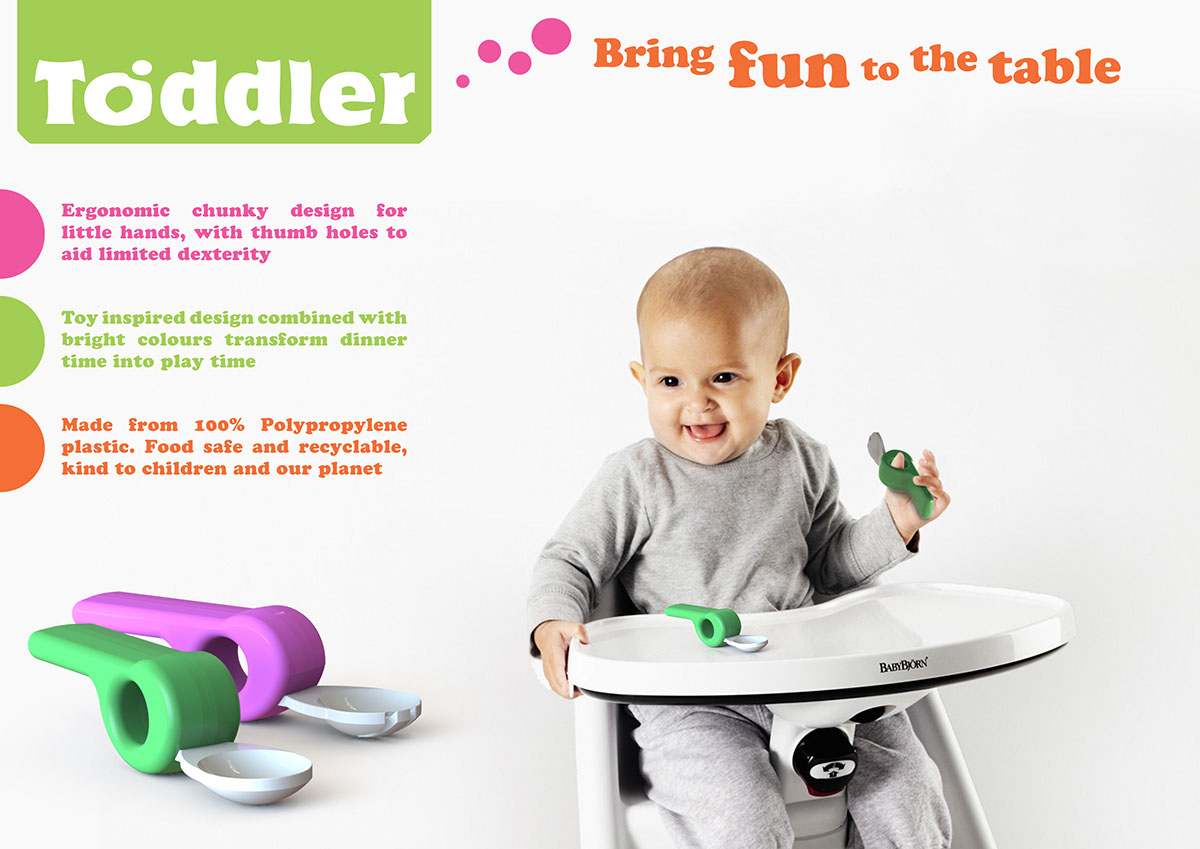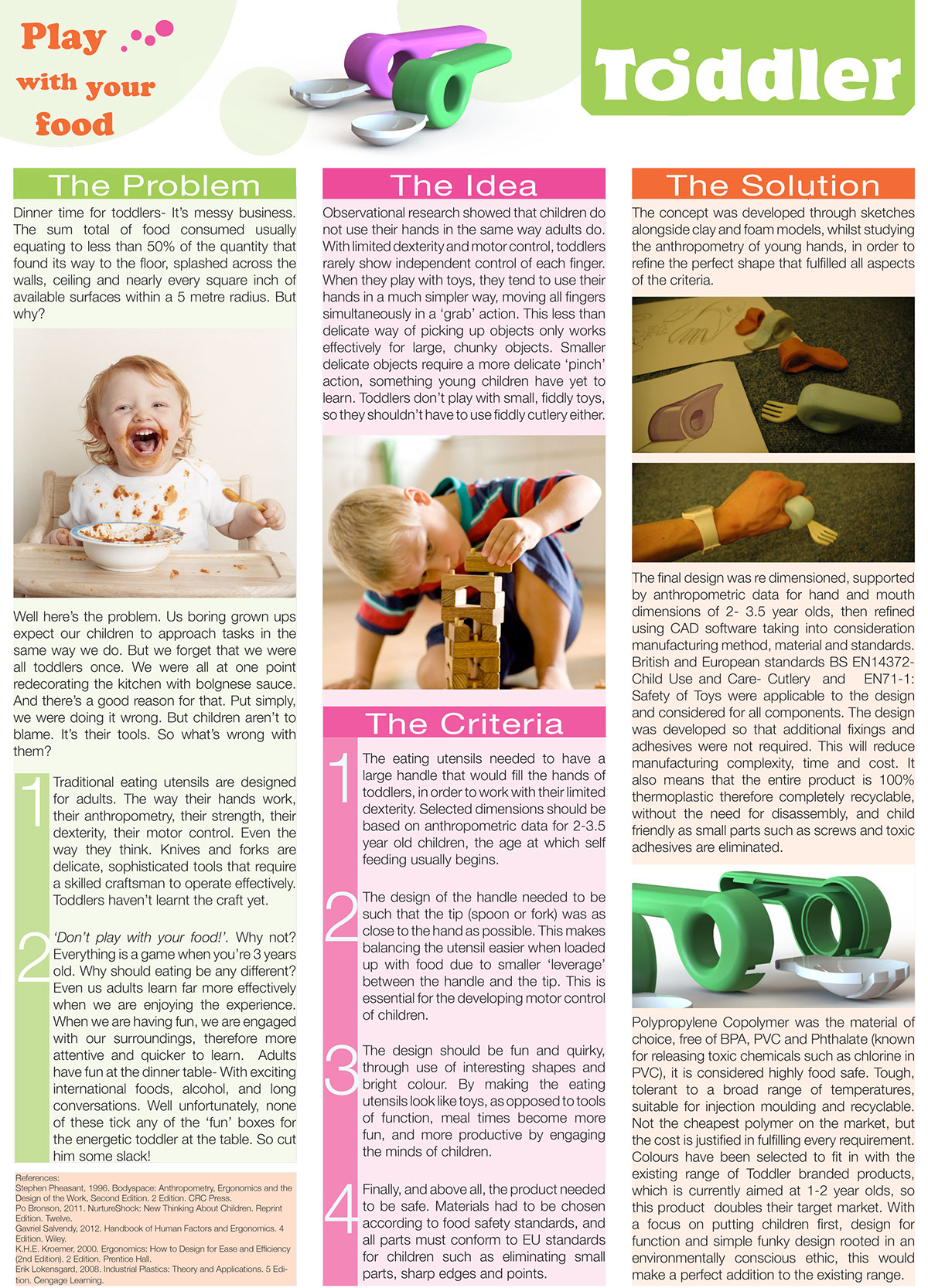
The Problem:
Dinner time for toddlers- It’s messy business. The sum total of food consumed usually equating to less than 50% of the quantity that found its way to the floor, splashed across the walls, ceiling and nearly every square inch of available surfaces within a 5 metre radius. But why?
Well here’s the problem. Us boring grown ups expect our children to approach tasks in the same way we do. But we forget that we were all toddlers once. We were all at one point redecorating the kitchen with bolgnese sauce. And there’s a good reason for that. Put simply, we were doing it wrong. But children aren’t to blame. It’s their tools. So what’s wrong with them?
1- Taditional eating utensils are designed for adults. The way their hands work, their anthropometry, their strength, their dexterity, their motor control. Even the way they think. Knives and forks are delicate, sophisticated tools that require a skilled craftsman to operate effectively. Toddlers haven't learnt the craft yet.
2- ‘Don’t play with your food!’. Why not? Everything is a game when you’re 3 years old. Why should eating be any different? Even us adults learn far more effectively when we are enjoying the experience. When we are having fun, we are engaged with our surroundings, therefore more attentive and quicker to learn. Adults have fun at the dinner table- With exciting international foods, alcohol, and long conversations. Well unfortunately, none of these tick any of the ‘fun’ boxes for the energetic toddler at the table. So cut him some slack!
The Idea:
Observational research showed that children do not use their hands in the same way adults do. With limited dexterity and motor control, toddlers rarely show independent control of each finger. When they play with toys, they tend to use their hands in a much simpler way, moving all fingers simultaneously in a ‘grab’ action. This less than delicate way of picking up objects only works effectively for large, chunky objects. Smaller delicate objects require a more delicate ‘pinch’ action, something young children have yet to learn. Toddlers don’t play with small, fiddly toys, so they shouldn’t have to use fiddly cutlery either.
The Criteria:
1- The eating utensils needed to have a large handle that would fill the hands of toddlers, in order to work with their limited dexterity. Selected dimensions should be based on anthropometric data for 2-3.5 year old children, the age at which self 2feeding usually begins.
2- The design of the handle needed to be such that the tip (spoon or fork) was as close to the hand as possible. This makes balancing the utensil easier when loaded up with food due to smaller ‘leverage’ between the handle and the tip. This is essential for the developing motor control of children.
3- The design should be fun and quirky, through use of interesting shapes and bright colour. By making the eating utensils look like toys, as opposed to tools of function, meal times become more fun, and more productive by engaging the minds of children.
4- Finally, and above all, the product needed to be safe. Materials had to be chosen according to food safety standards, and all parts must conform to EU standards for children such as eliminating small parts, sharp edges and points.

The Solution:
The concept was developed through sketches alongside clay and foam models, whilst studying the anthropometry of young hands, in order to refine the perfect shape that fulfilled all aspects of the criteria.
The final design was re dimensioned, supported by anthropometric data for hand and mouth dimensions of 2- 3.5 year olds, then refined using CAD software taking into consideration manufacturing method, material and standards. British and European standards BS EN14372- Child Use and Care- Cutlery and EN71-1: Safety of Toys were applicable to the design and considered for all components. The design was developed so that additional fixings and adhesives were not required. This will reduce manufacturing complexity, time and cost. It also means that the entire product is 100% thermoplastic therefore completely recyclable, without the need for disassembly, and child friendly as small parts such as screws and toxic adhesives are eliminated.
Polypropylene Copolymer was the material of choice, free of BPA, PVC and Phthalate (known for releasing toxic chemicals such as chlorine in PVC), it is considered highly food safe. Tough, tolerant to a broad range of temperatures, suitable for injection moulding and recyclable. Not the cheapest polymer on the market, but the cost is justified in fulfilling every requirement. Colours have been selected to fit in with the existing range of Toddler branded products, which is currently aimed at 1-2 year olds, so this product doubles their target market. With a focus on putting children first, design for function and simple funky design rooted in an environmentally conscious ethic, this would make a perfect addition to the existing range.



